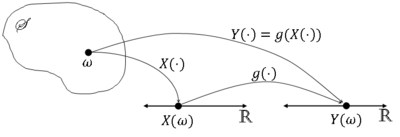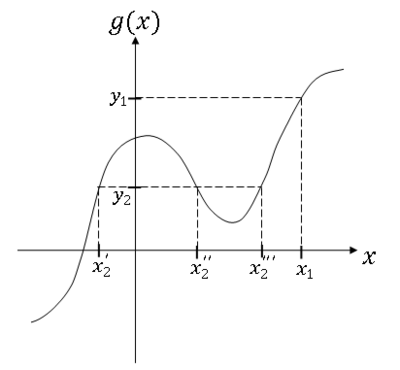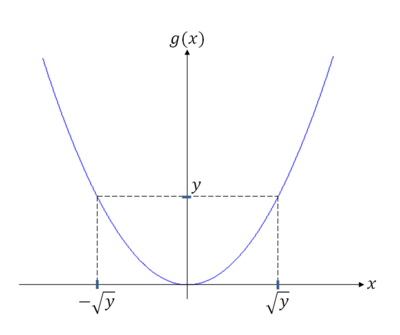| Line 60: | Line 60: | ||
'''Case 2''': X continuous, Y discrete <br/> | '''Case 2''': X continuous, Y discrete <br/> | ||
The pmf of Y in this case is <br/> | The pmf of Y in this case is <br/> | ||
| − | <center>p<math>_Y</math>(y) = P(g(X)=y) = P(X ∈ D< | + | <center>p<math>_Y</math>(y) = P(g(X)=y) = P(X ∈ D<math>_Y</math>) =</center><br/> |
<center>where D<math>_Y</math> ≡ {x ∈ '''R''': g(x)=y} ∀y ∈ ''R''<math>_Y</math></center> | <center>where D<math>_Y</math> ≡ {x ∈ '''R''': g(x)=y} ∀y ∈ ''R''<math>_Y</math></center> | ||
| + | |||
| + | Then, <br/> | ||
| + | <center><math> p_Y(y) = \int_{D_y}f)X(x)dx</math></center> | ||
| + | |||
| + | '''Example''' Let g(x) = u(x - x<math>_0</math>) for some x<math>_0</math> ∈ '''R''', and let Y=g(X). Then <math>R_Y</math> = {0,1} and <br/> | ||
| + | <center> D<math>_0</math> = {x ∈ '''R''': x < x<math>_0</math>} = (-∞, x<math>_0</math>)</center> | ||
| + | <center> D<math>_1</math> = {x ∈ '''R''': x ≥ x<math>_0</math>} = [ x<math>_0</math>, ∞)</center> | ||
| + | So, <br/> | ||
| + | <center><math> p_Y(y) = \begin{cases} | ||
| + | \int_{-\infty}^{x_0} f_X(x)dx & y=0\\ | ||
| + | \\ | ||
| + | \int_{x_0}^{-\infty} f_X(x)dx & y=1 | ||
| + | \end{cases}</math></center> | ||
| + | |||
| + | |||
| + | '''Case 3:''' X and Y continuous <br/> | ||
| + | |||
| + | We will discuss 2 methods for finding f<math>_Y</math> in this case. | ||
| + | |||
| + | '''Approach 1'''<br/> | ||
| + | First, find the cdf F<math>_Y</math>. <br/> | ||
| + | <center>F<math>_Y</math>(y) = P(g(X) ≤ y) = P(X ∈ D<math>_y</math>) <br/> | ||
| + | where D<math>_y</math> = {x ∈ '''R''': g(x) ≤ y}.</center> | ||
| + | Then <br/> | ||
| + | <center><math>F_Y(f) = \int_{D_y}f_X(x)dx</math></center> | ||
| + | |||
| + | Differentiate F<math>_Y</math> to get f<math>_y</math>. | ||
| + | |||
| + | You can find D<math>_Y</math> graphically or analytically | ||
| + | |||
| + | |||
| + | '''Example''' | ||
| + | |||
| + | <center>[[Image:fig2_functions_on_rv.png|400px|thumb|left|Fig 2: This plot of g(x) can be used to derive D</math>_Y</math> graphically]]</center> | ||
| + | |||
| + | |||
| + | For y = y<math>_1</math> and y = y<math>_2</math>, <br/> | ||
| + | <center><math>\begin{align} | ||
| + | D_{y_1} &= \{x:\;x \leq x_1\} \\ | ||
| + | D_{y_2} &= \{x:\;x\leq x_2'\} \cup \{x:\;x_2''<x\leq x_2'''\} | ||
| + | \end{align}</math></center> | ||
| + | |||
| + | Then <br/> | ||
| + | <center><math>\begin{align} | ||
| + | F_Y(y_1) &= \int_{-\infty}^{x_1}f_X(x)dx \\ | ||
| + | \\ | ||
| + | F_Y(y_2) &= \int_{-\infty}^{x_2'}f_X(x)dx + \int_{x_2''}^{x_2'''}f_X(x)dx | ||
| + | \end{align}</math></center> | ||
| + | |||
| + | |||
| + | '''Example''' Y = aX + b, a,b ∈ '''R''', a ≠ 0<br/> | ||
| + | <center>F<math>_Y</math>(y) = P(aX + b ≤ y)</center> | ||
| + | So, <br/> | ||
| + | <center><math>\begin{align} | ||
| + | D_y&=\{x\in\mathbb R: x\leq\frac{y-b}{a}\}\quad\mbox{if}\;a>0 \\ | ||
| + | D_y&=\{x\in\mathbb R: x\geq\frac{y-b}{a}\}\quad\mbox{if}\;a<0 | ||
| + | \end{align}</math></center> | ||
| + | Then <br/> | ||
| + | <center><math>F_Y(y)=\begin{cases} | ||
| + | \int_{-\infty}^{\frac{y-b}{a}}f_X(x)dx & \mbox{if }\;a>0 \\ | ||
| + | \\ | ||
| + | \int_{\frac{y-b}{a}}^{-\infty}f_X(x)dx & \mbox{if }\;a<0 | ||
| + | \end{cases}</math></center> | ||
| + | |||
| + | |||
| + | '''Example''' Y = X<math>^2</math> <br/> | ||
| + | |||
| + | <center>[[Image:fig3_functions_on_rv.png|400px|thumb|left|Fig 3: y = x<math>^2</math>]]</center> | ||
| + | |||
| + | |||
| + | For y < 0, D<math>_y</math> = ø <br/> | ||
| + | For y ≥ 0, <br/> | ||
| + | <center><math>\begin{align} | ||
| + | F_Y(y) &= P(X^2\leq y) \\ | ||
| + | &= P(-\sqrt{y} <X\leq \sqrt{y}) | ||
| + | \end{align}</math></center> | ||
| + | So, <br/> | ||
| + | <center><math> D_y = (-\sqrt{y},\sqrt{y})</math></center> | ||
| + | and <br/> | ||
| + | <center><math>F_Y(y) = \int_{-\sqrt{y}}^{\sqrt{y}}f_X(x)dx</math></center> | ||
Revision as of 10:03, 13 October 2013
Random Variables and Signals
Topic 8: Functions of Random Variables
We often do not work with the random variable we observe directly, but with some function of that random variable. So, instead of working with a random variable X, we might instead have some random variable Y=g(X) for some function g:R → R.
In this case, we might model Y directly to bet f$ _Y $(y), especially if we do not know g. Or we might have a model for X and find f$ _Y $(y) (or p$ _Y $(y)) as a function of f$ _X $ (or p$ _X $ and g.
We will discuss the latter approach here.
More formally, let X be a random variable on (S,F,P) and consider a mapping g:R → R. Then let Y$ (\omega)= $g(X($ \omega)) $ ∀$ \omega $ ∈ S.
We normally write this as Y=g(X).
Graphically,
Is Y a random variable? We must have Y$ ^{-1} $(A) ≡ {$ \omega $ ∈ S: Y$ (\omega) $ ∈ A} = {$ \omega $ ∈ S: g(X$ (\omega) $) ∈ A} be an element of F ∀A ∈ B(R) (Y must be Borel measurable).
We will only consider functions g in this class for which Y$ ^{-1} $(A) ∈ F ∀A ∈ B(R), so that if Y=g(X) for some random variable X, Y will be a random variable.
What is the distribution of Y? Consider 3 cases:
- X discrete, Y discrete
- X continuous, Y discrete
- X continuous, Y continuous
Note: you cannot have a continuous Y from a discrete X.
Case 1: X & Y discrete
Let $ R_X $≡ X(S) be the range space of X and math>R_Y</math>≡ g(X(S)) be the range space of Y. Then the pmf of Y is
But this means that
Example $ \quad $ Let X be the value rolled on a die and
Then R$ _X $ = {0,1,2,3,4,5,6} and R$ _Y $ = {0,1} and g(x) = x % 2.
Now
Case 2: X continuous, Y discrete
The pmf of Y in this case is
Then,
Example Let g(x) = u(x - x$ _0 $) for some x$ _0 $ ∈ R, and let Y=g(X). Then $ R_Y $ = {0,1} and
So,
Case 3: X and Y continuous
We will discuss 2 methods for finding f$ _Y $ in this case.
Approach 1
First, find the cdf F$ _Y $.
where D$ _y $ = {x ∈ R: g(x) ≤ y}.
Then
Differentiate F$ _Y $ to get f$ _y $.
You can find D$ _Y $ graphically or analytically
Example
For y = y$ _1 $ and y = y$ _2 $,
Then
Example Y = aX + b, a,b ∈ R, a ≠ 0
So,
Then
Example Y = X$ ^2 $
For y < 0, D$ _y $ = ø
For y ≥ 0,
So,
and




